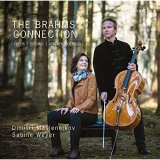Mit den jeweils 1. Sonaten für Cello und Klavier von Robert Fuchs, Johannes Brahms und Heinrich von Herzogenberg erleben wir die luxemburgische Pianistin Sabine Weyer und ihren langjährigen Cello-Partner Dimitri Maslennikov. The Brahms Connection bietet satte 78 Minuten Musik und lässt den Hörer nicht nur an exzellenten Interpretationen teilhaben, sondern ggf. auch die unbekanntere Musik von Fuchs und Herzogenberg kennenlernen. Dabei ist für mich die Fuchs-Sonate ein absolutes Highlight. Bereits der erste Satz, ein Molto moderato, besitzt einen ungewöhnlichen, ja innovativen Charakter, der bereits auf die kommende Generation von Komponisten verweist.
Über seine 1. Sonate für Cello und Klavier sagte Heinrich von Herzogenberg: « Ich präsentiere Euch einen wahren Waldteufel, und kein Professorenstück, wie Ihr wohl erwartet! Sie werden vielleicht fragen, warum man dem feuchten Baryton, dem Liebling der Damen [= Cello] solche Dinge zumuthet? Ganz einfach, weil ich immer fand, dass kein Instrument so geeignet sei, den Grimm (manchmal das Grimmen) darzustellen, wie eben das Violoncell.“ Es ist eine außergewöhnliche Komposition, immer originell und durchaus unterhaltsam.
Inmitten dieser beiden Sonaten ist die 1. Sonate von Brahms zu hören, von Maslennikov und Weyer sehr empathisch und elegisch gespielt. Was die hohe Kunst der beiden aber ausmacht, ist ihre Suche nach der vollendeten Balance und die perfekte Interaktion zwischen den Stimmen und Stimmungen.
Wir erleben drei stilistisch sehr unterschiedliche Interpretationen von drei Komponisten, die sich kannten und schätzten. Bei jedem dieser Komponisten finden Maslennikov und Weyer eine eigene Sprache und eine sehr individuelle Interpretation. Dabei gibt es keine Ego-Virtuosität, sondern Demut und Bescheidenheit, aber trotzdem auch Verve und Spielfreude sowie einen untrüglichen Sinn für Tiefe. Allerdings ist die Aufnahme recht basslastig und dunkel, so dass die tiefen Töne eher schwammig daherkommen und den subtilen Interpretationen etwas von ihrem Charme nehmen.
With the first sonatas for cello and piano by Robert Fuchs, Johannes Brahms and Heinrich von Herzogenberg respectively, we experience the playing of Luxembourg pianist Sabine Weyer and her long-time cello partner Dimitri Maslennikov. The Brahms Connection offers a whopping 78 minutes of music and allows the listener not only to participate in excellent interpretations, but also, where appropriate, to become acquainted with the lesser-known music of Fuchs and Herzogenberg. For me, the Fuchs Sonata is an absolute highlight. Already the first movement, a Molto moderato, has an unusual, even innovative character, which already points to the coming generation of composers.
Heinrich von Herzogenberg wrote about his 1st Sonata for Cello and Piano, « I present to you a true forest devil, and not a professorial piece, as you might expect! You will perhaps ask why the damp baryton, the darling of the ladies [= cello] is expected to do such things? Quite simply because I have always found that no instrument is as suitable for portraying the Grimm (sometimes the Grimmen) as the violoncello. » It is an extraordinary composition, always original and thoroughly entertaining.
In the midst of these two sonatas, the 1st Sonata by Brahms can be heard, played by Maslennikov and Weyer very empathically and elegiacally. But what makes the high art of the two is their search for the perfect balance and the perfect interaction between the voices and moods.
We experience three stylistically very different interpretations of three composers who knew and appreciated each other. With each of these composers, Maslennikov and Weyer find their own language and a very individual interpretation. There is no ego virtuosity, but humility and modesty, yet also verve and joy of playing as well as an unerring sense of depth.
However, the recording is rather bass-heavy and dark, so that the low notes come across rather spongy and take away some of the charm of the subtle interpretations.
























